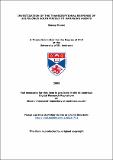Files in this item
Investigation of the transcriptional response of Sulfolobus solfataricus to damaging agents
Item metadata
| dc.contributor.advisor | White, Malcolm F. | |
| dc.contributor.author | Munro, Stacey | |
| dc.coverage.spatial | xx, 200 p. | en |
| dc.date.accessioned | 2009-08-31T08:20:13Z | |
| dc.date.available | 2009-08-31T08:20:13Z | |
| dc.date.issued | 2009 | |
| dc.identifier | uk.bl.ethos.552274 | |
| dc.identifier.uri | https://hdl.handle.net/10023/743 | |
| dc.description.abstract | It is vital for the survival of an organism that it can repair damage to its DNA. Exogenous and endogenous sources of damage are dealt with by a variety of repair pathways that have evolved to repair specific types of damage. Organisms in the archaeal domain, the third domain of life, contain homologues of many of the eukaryotic repair proteins, however little is known about how damage is detected in the archaeal domain. Microarray studies in the archaeal species Sulfolobus solfataricus determined a number of genes whose expression was effected by UV radiation (work by Dr D Götz). The change in expression of nine of these genes was confirmed by RT real time PCR. The expression of these genes was then investigated after exposure to different damaging agents, Mitomycin C, Methyl methane sulfonate, Phleomycin and Hydrogen peroxide. The expression of two genes, transcription factor tfb-3 and cell division control gene cdc6-2, was up regulated in all damage conditions. There was a huge induction of the dps-like gene (sso2079) after hydrogen peroxide damage. Transcription from this genes promoter was shown to be strong in vitro (work by Dr S Paytubi) suggesting a repressor was controlling the gene in vivo. A palindromic repeat in the promoter of the dps-like gene was used to ‘fish’ for a transcriptional repressor and the Sso2273 protein, a homologue of the diphtheria toxin repressor (DtxR) from Corynebacterium diphtheria, was identified as a possible repressor. Sso2273 was expressed and purified, and its crystal structure solved, its paralogue, Sso0669, was also expressed and purified. Electrophoretic mobility shift assays showed that the Sso2273 protein does not bind DNA, and had no effect on transcription from any promoter used in in vitro transcription assays. However Sso0669 appeared to inhibit transcription, although the inhibition was not sequence specific. A knockout strain of S. solfataricus PBL2025 missing the sso2273 gene was produced and used in microarray experiments in an attempt to determine the role of Sso2273 within the cell. The absence of Sso2273 appeared to have no effect on the expression of the dps-like gene, however strong repression of an operon containing genes involved in Sulphur assimilation was observed. | en |
| dc.format.extent | 10842230 bytes | |
| dc.format.mimetype | application/pdf | |
| dc.language.iso | en | en |
| dc.publisher | University of St Andrews | |
| dc.subject.lcc | QH467.M8 | |
| dc.subject.lcsh | DNA repair | en |
| dc.subject.lcsh | Archaebacteria | en |
| dc.title | Investigation of the transcriptional response of Sulfolobus solfataricus to damaging agents | en |
| dc.type | Thesis | en |
| dc.type.qualificationlevel | Doctoral | en |
| dc.type.qualificationname | PhD Doctor of Philosophy | en |
| dc.publisher.institution | The University of St Andrews | en |
This item appears in the following Collection(s)
Items in the St Andrews Research Repository are protected by copyright, with all rights reserved, unless otherwise indicated.

